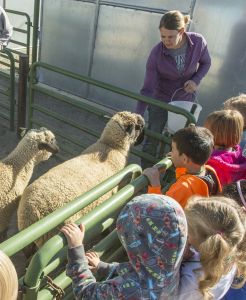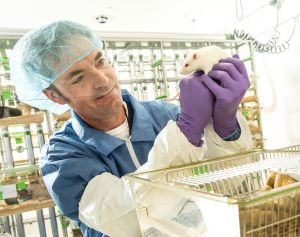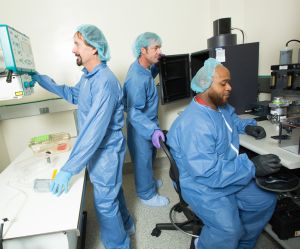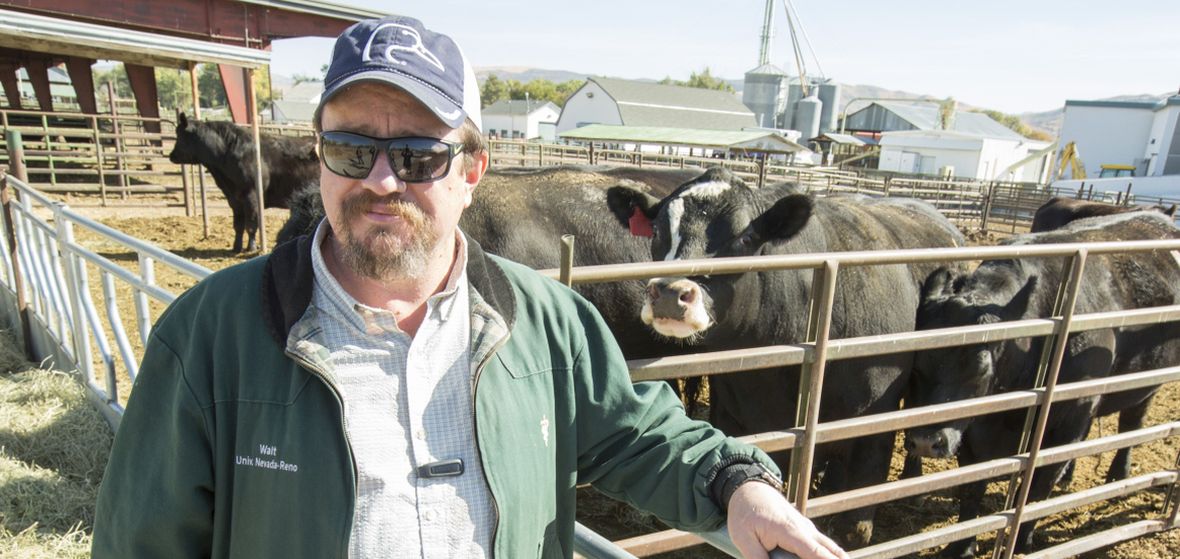The University of Nevada, Reno connects with animals in many ways, from those in the farm settings of the Nevada Agricultural Experiment Station to those in research and teaching programs both in observed field settings and in campus laboratories. To more accurately reflect this wide span of responsibility, the University's Lab Animal Medicine department has changed its name to the office of Animal Resources.
 Mamie Towles Elementary School students learn about animals from Cara Goff, Main Station Farm manager and research technician.
Mamie Towles Elementary School students learn about animals from Cara Goff, Main Station Farm manager and research technician.The new name comes on the heels of the University's renewed, full accreditation awarded this summer from the Association for Assessment and Accreditation of Laboratory Care International, a private, nonprofit organization that promotes the humane treatment of animals in science. This voluntary and internationally recognized accreditation was first awarded to the University in 2007 and demonstrates the institution's commitment to go beyond the standards required by law to achieve excellence in animal care and use.
'ABOVE AND BEYOND' TEAM
The Animal Resources team of veterinarians and certified professionals, part of the University's Research & Innovation and guided by Director and Campus Attending Veterinarian Ben Weigler, oversees animal care and provides veterinary services University-wide. They oversee regulatory compliance, administer the faculty-led Institutional Animal Care and Use Committee (IACUC), facilitate required and other training for faculty and staff who work with animals, give guest lectures and help develop curriculum and learning opportunities for students in different programs on campus.
"Our focus is animal welfare and on-going improvement," said Weigler, an accomplished veterinarian and researcher who joined the University in 2015.
That commitment is demonstrated by a goal recently achieved by the Animal Resources team: all members of the animal care staff are now certified by the American Association for Laboratory Animal Science. The widely recognized AALAS Certification Program advances professional standards for laboratory-animal care and technology.
In addition to Weigler, the Animal Resources team includes veterinarian Walt Mandeville. Though Mandeville works with all animals, large and small, he spends a good deal of time working with large animals, namely cows and sheep, in the farm settings of the Nevada Agricultural Experiment Station, including the Main Station Farm and Gund Ranch. Of the staff that work in these settings and the level of care they provide, Mandeville said, "They are way ahead of the game."
"In so many ways the Animal Resources team goes above and beyond what's expected or required," said Charlene Hart, assistant vice president for research administration and to whom Animal Resources reports. "Through their commitment and professionalism, they make an important contribution to research, teaching and service, and they take great pride in doing so."
 Keeping animals safe, clean and comfortable is a priority for Jared Smith, certified technician.
Keeping animals safe, clean and comfortable is a priority for Jared Smith, certified technician.RIGOROUS REVIEW
The University's animal program is complex, and the corresponding rigorous review is valued. Weigler views it as key to maintaining the focus on continuous improvement.
When it comes to maintaining a quality program committed to appropriate care and humane treatment of animals, the IACUC is key. The committee oversees the University's animal care and use programs, facilities and procedures, and its purview includes all animals in the University's programs for research and teaching, across the span of the basic sciences, biomedical research, agricultural and wildlife settings.
The IACUC reviews all requests to use vertebrate animals and works to ensure compliance with state, federal and international regulations. Members of the IACUC also perform twice-a-year inspections of areas where animals are housed and used. Joining the faculty members of the IACUC are two non-science committee members from the Reno-Sparks community who represent public interests and participate in all areas of IACUC responsibility.
"While IACUC is responsible for ensuring regulatory compliance, the committee views its role as one of service to the faculty, technicians, students and administrators, as well as the general public," Weigler said. "They provide guidance toward the goal to attain the highest quality of animal care coexistent with attaining the ultimate in quality scientific results."
In addition to IACUC oversight and the AAALAC accreditation review, the University's animal program is reviewed annually, at a minimum, by the USDA and is subject to oversight by the Office of Animal Laboratory Welfare, part of the National Institutes of Health.
PARTNERS IN RESEARCH
The National Institutes of Health and others use the mantra that good science and good animal care go hand in hand.
"We are partners to the researchers and scientists," Weigler said. "In research, (veterinary care) is not discretionary."
 Director Ben Weigler joins technicians Jared Smith and Akeem Greene to check the state-of-the-art imaging and lab equipment available for animal care.
Director Ben Weigler joins technicians Jared Smith and Akeem Greene to check the state-of-the-art imaging and lab equipment available for animal care.The vast majority of animals involved in research at the University are rodents, such as mice and rats, bred for study to advance medicine and science. In keeping with AAALAC standards, animals are involved in research only when there are no non-animal alternatives and when it is done in an ethical and humane way.
Birds, fish, large game, reptiles and various endangered or threatened species are examples of the many types of animals that are the subject of observational research or field study by University faculty. Even for observational research or field study, protocols approved by the IACUC must be in place to guide possible interactions with or injuries to the animals involved.
To give faculty and researchers an on-going mechanism for input and the opportunity to forecast future needs, Animal Resources has initiated a new Animal Advisory Group. To learn more about or join the quarterly discussion, contact Weigler at bweigler@unr.edu.











